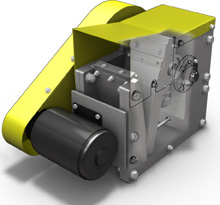
Designed Use
Jaw crushers work best on hard, brittle (friable) products and work most efficiently at a reduction ratio of up to 6 to 1. They can sometimes be effective at higher ratios, but with greater wear.
Typical applications are soda lime glass, borosilicate glass, fused minerals, metal oxides, metal oxides, catalysts, siliceous slag, hard minerals & refractory materials.
Feeding
Crushed material size is controlled by the jaw gap, the throw/stroke of the toggle, and the friability of the product. These crushers must be control fed, not choke fed.
Jaw crushing is a simple way to both control the top size to a roll crusher without screening, and also maximize the efficiency of a roll crusher.
Construction
Our crushers are constructed of all steel, for maximum strength and shock resistance. The alloy steel jaw and cheek plates are hard faced and are reversible for maximum life between re-application of the manganese facing. These normally can be re-faced several times before replacement.
The forged steel shaft is carried in extreme duty bearings. Jaw gap is adjustable by shims. The all steel frame (stronger and more ductile than cast iron) is primarily bolted through high tensile connections, so stress fractures in castings or welds is eliminated.
|
Sample crushing, pilot plant, and production crushing of: • Basalt • Borosilicate glass • Ceramics • Char • Clinker • Coal • Coke • Expanded clay • Feldspar • Fused alumina • Grog • Lime • Metal oxides • Minerals & ores • Perlite • Quartz • Silicon • Slag • Soda Lime Glass • Zirconia |
 |